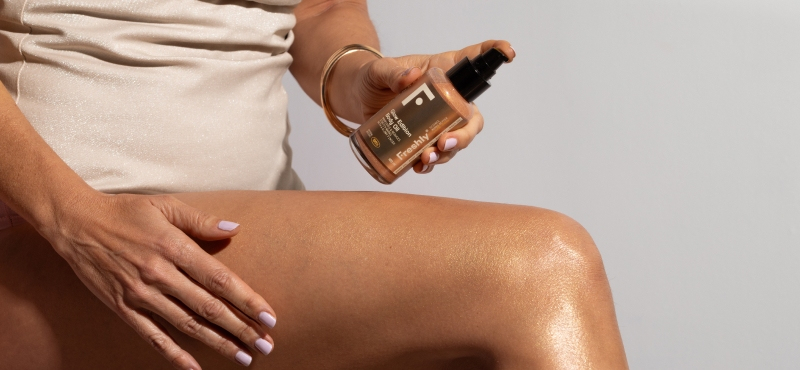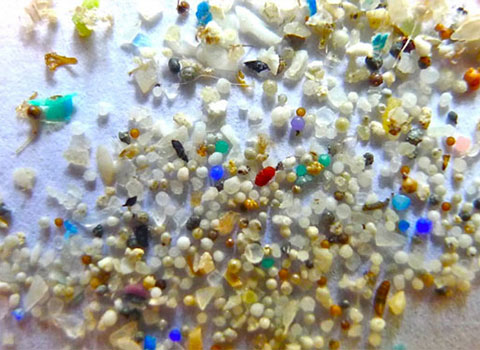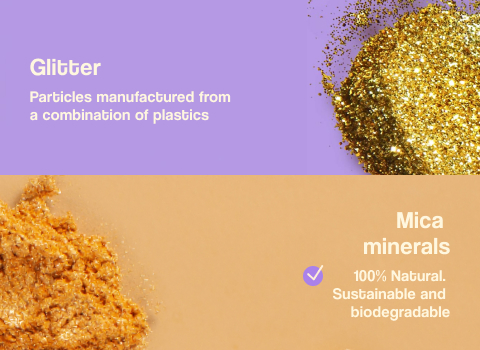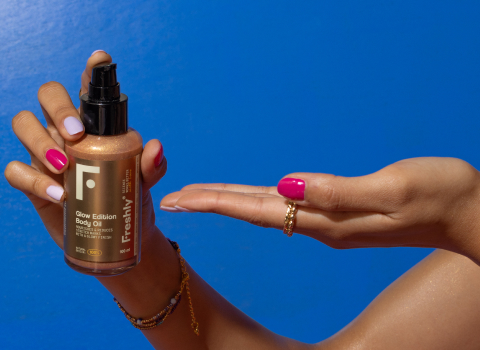Discover the power of micas. Make your skin glow while caring for the planet

Here are your essentials
for making it this far
Fancy some glow? Then, this post is for you. If you're looking to make your skin look juicy with amazing golden sparkles, but you also care about the planet and are aware of the microplastics issue, we have good news! You might be wondering: What do these two things have to do with each other? Here comes the explanation...
With the good weather comes the time to see our skin in all its glory, and we normally use oils or body creams with a glowy touch and sparkles to enhance it, to see it juicy and radiant. But… Did you know that many of these cosmetic products contain glitter and/or purpurina in their formulations to achieve that special effect? That is, microplastics or rather microplastic particles that reflect light creating those desired sparkles. However, there's a natural alternative to these plastic particles that is much more beneficial for the skin and the planet, as they are biodegradable: micas.
An important fact! “Every year, it is estimated that 8 million tons of plastic end up in the ocean.” Did you know that the cosmetic products we use every day are a significant source of microplastics?
So let's talk about this situation, the issue of microplastics, what they are, where they come from, what they mean for the planet, what they have to do with cosmetics, and how we can do to take better care of our planet, while achieving... achieving juicy, healthy, and appealing skin at the same time. Are you in?

What are microplastics? Where do they come from?
Microplastics are particles of very different sizes, ranging from 0.05 mm to 1 mm, composed of different types of plastics such as polyethylene, polymethylmethacrylate, nylon, polyethylene terephthalate, or polypropylene.
These tiny plastic particles are present in many objects, including everyday items like clothing and cosmetics.
Microplastics and cosmetics
We need to become aware. By using products that contain these particles on our body, many of them end up in our shower, later in the drains, and finally in wastewater treatment plants. But being such small particles, some cannot be detected nor separated by purification systems, so they end up in our rivers, lakes, and oceans. As a consequence, they may be ingested by fish and marine species or deposited on the sand on the beach...
“Research by the United Nations Environment Programme (UNEP) shows that continued use of some of these products increases the accumulation of microplastics in the environment.”
How do I detect if there are microplastics in my cosmetics?
Detection is very simple, we just have to see if the list of ingredients of the product (INCI) contains the words polyethylene (PE), polymethylmethacrylate (PMMA), nylon, polyethylene terephthalate (PET), or polypropylene (PP). Remember that the list of ingredients in a cosmetic is usually found on the back of the package.
According to the UNEP's Global Chemicals Outlook II report. "Some scrubs contain more than 10% microbeads, a type of primary microplastic. Also, in a recent study, the Plastic Soup Foundation's Beat the Microbead campaign found that 83% of 138 brands of hand sanitizers and gels contained microplastics.”
What alternatives to microplastics are there in cosmetics?
Natural cosmetic products are made with the aim of respecting the environment with the use of natural ingredients free of plastics that are respectful to people, animals, and the environment. For example, natural exfoliants based on salt, sugar, or particles of seeds and shells of various fruits or vegetables are part of this group. At Freshly, we opt for these types of natural ingredients free of plastic particles in all our products.
Exfoliants without microplastics, the alternative? Biodegradable natural particles
For example, our natural exfoliant includes particles such as raspberry seeds and bamboo powder, two fully biodegradable ingredients. We also have a natural and eco-friendly bamboo toothbrush, and biodegradable sunscreens for adults and kids, free of polluting particles, respectful of the environment and people.
Micas. Why use microplastics when you can illuminate your body with mineral micas?
Micas are natural ingredients of mineral origin that are abundant in nature and are characterised by their beautiful shine. These minerals have multiple shades and are ground into small particles to create mica powder that is used as a pigment in the formulations of natural cosmetic products. This magnificent powder emits gorgeous sparkles that allow to add a very natural shine to the skin while we take care of our organism and the planet.
These particles, when they come off the skin, for example, in the shower, do not pollute our oceans, as they are natural. Their particle size means they do not penetrate the skin, so their function is entirely superficial. Moreover, they have been tested as non-irritating, and they generate an antioxidant protective effect for the skin.

What does it mean to use glitter? Glitter is a microplastic. And as we said, by applying it to our body, it can end up in our seas and oceans.
When you choose formulas free of microplastics, you express your love for the world.
**If you would like more information, here are 2 links where you can find out more:
-https://www.unep.org/news-and-stories/story/microplastics-long-legacy-left-behind-plastic-pollution
-https://www.unep.org/interactive/whats-in-your-bathroom/
Freshly wants to tell you something! At Freshly we keep on learning every day how to make decisions that bring us closer to a better future. Sometimes we are called dreamers, but what we really have is an optimistic vision and clear path for reaching that tomorrow.
Would you like to join this adventure? If you're here, it's because you are a demanding person when it comes to taking care of your body and the planet. By subscribing to the newsletteryou will receive articles like this one to continue learning, as well as news and exclusive discounts. Are you up for it?




